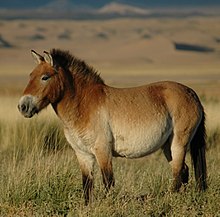| Przewalski's horse | |
|---|---|

| |
| Scientific classification | |
| Domain: | Eukaryota |
| Kingdom: | Animalia |
| Phylum: | Chordata |
| Class: | Mammalia |
| Order: | Perissodactyla |
| Family: | Equidae |
| Genus: | Equus |
| Species: | |
| Subspecies: | E. f. przewalskii
|
| Trinomial name | |
| Equus ferus przewalskii (I. S. Polyakov, 1881)
| |

| |
| Przewalski's horse range (IUCN distribution of Przewalski's horse, where it is extant & reintroduced to 5 disjointed areas in Northern China and Southern Mongolia; missing distribution in Russia, Belarus, and Ukraine) | |
| Synonyms | |
| |
Przewalski's horse (/(p)ʃəˈvɑːlskiːz, ˌpɜːrʒə-/ (p)shə-VAHL-skeez, PUR-zhə-;[3] Russian: [prʐɨˈvalʲskʲɪj] (Пржевальский); Polish: [pʂɛˈvalskʲi]; Equus ferus przewalskii or Equus przewalskii[4]), also called the takhi (Mongolian: Тахь),[5] Mongolian wild horse or Dzungarian horse, is a rare and endangered horse originally native to the steppes of Central Asia. It is named after the Russian geographer and explorer Nikolay Przhevalsky. Once extinct in the wild, since the 1990s it has been reintroduced to its native habitat in Mongolia in the Khustain Nuruu National Park, Takhin Tal Nature Reserve, and Khomiin Tal, as well as several other locales in Central Asia and Eastern Europe.[1]
Several genetic characteristics of Przewalski's horse differ from what is seen in modern domestic horses, indicating neither is an ancestor of the other. For example, Przewalski's horse has 33 chromosome pairs, compared to 32 for the domestic horse. Their ancestral lineages split from a common ancestor between 160,000 and 38,000 years ago, long before the domestication of the horse. Przewalski's horse was long considered the only remaining truly wild horse, in contrast with the American mustang and the Australian brumby, which are instead feral horses descended from domesticated animals. That status was called into question when domestic horses of the 5,000-year-old Botai culture of Central Asia were found to be more closely related to Przewalski's horses than to E. f. caballus. The study raised the possibility that modern Przewalski's horses could be the feral descendants of the domestic Botai horses. However, it remains possible that both the Botai horses and the modern Przewalski's horses descend separately from the same ancient wild Przewalski's horse population. Its taxonomic position is still debated, with some taxonomists treating Przewalski's horse as a species, E. przewalskii, others as a subspecies of wild horse (E. ferus przewalskii) or a variety of the domesticated horse (E. caballus).
Przewalski's horse is stockily built, smaller, and shorter than its domesticated relatives. Typical height is about 12–14 hands (48–56 inches, 122–142 cm), and the average weight is around 300 kg (660 lb). They have a dun coat with pangaré features and often have dark primitive markings.
- ^ a b Cite error: The named reference
IUCNwas invoked but never defined (see the help page). - ^ "Appendices | CITES". cites.org. Retrieved 14 January 2022.
- ^ "Przewalski's horse". Merriam-Webster.com Dictionary. Merriam-Webster. Retrieved 29 April 2023.
- ^ Cite error: The named reference
STWHwas invoked but never defined (see the help page). - ^ "Takhi: Holy Animal of Mongolia". International Takhi Group. Retrieved 13 August 2016.
